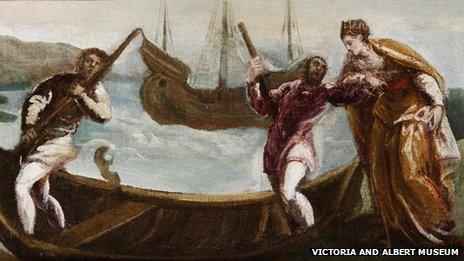Tintoretto painting uncovered at London V&A museum
- Published

The painting is believed to have been executed around 1555
A painting in the Victoria and Albert Museum has been found to be a work by Italian master Jacopo Tintoretto.
Until recently, The Embarkation of St Helena in the Holy Land was attributed to his contemporary Andrea Schiavone.
But new analysis of the work has revealed it as one of a series of three paintings by Tintoretto, depicting the legend of St Helena And The Holy Cross.
The error was uncovered during work on a project to catalogue continental European oil paintings in the UK.
Detailed records of more than 1,000 paintings have so far gone online as part of the National Inventory of Continental European Paintings (Nice), which aims to catalogue and digitise around 22,000 pre-1900 artworks of continental European origin held in public collections in Britain.
The work by Tintoretto (1518-1594), one of 200 paintings at the Victoria and Albert Museum to be reattributed or re-identified, forms part of an exhibition at the V&A which highlights 10 of the most interesting discoveries.
"Although clearly of high quality, this painting was a puzzle. The subject matter could not be determined, and the canvas support was unusual for such a small painting," the curator of the exhibition has written, alongside the newly discovered Tintoretto.
"It had been catalogued as a work by Andrea Schiavone, a Venetian artist of Croatian origins. Yet the style, with its broken brushwork and a palette of cool greys offset by white, ochre and carmine, is typical of early work by Tintoretto."
The Embarkation of St Helena was acquired by the V&A in 1865. Its sister paintings, The Discovery Of The True Cross and St Helen Testing The True Cross, are held in galleries in the US.
Helena, mother of the Emperor Constantine, is said to have found the actual cross on which Christ was crucified.
Research On Paintings: Technical art history and connoisseurship, is running at the Victoria and Albert Museum until 22 September.
- Published9 June 2010